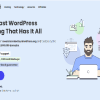

So if you’re tempted to go for cheap web hosting, first review these 10 crucial ways that speed can affect your customers’ experience and your bottom line.
1. Many visitors abandon websites that take a long time to load
A website’s bounce rate is the percentage of users who visit your website only to head back to wherever they came from. For whatever reason, they decide not to interact with your website further. Reducing the bounce rate of your website is a big part of optimizing it.
Page load speed has a huge effect on average bounce rates. Around 47% of consumers expect a site to load within two seconds, and 40% of visitors will bounce when page speed is over three seconds. If your website takes even longer to load, expect to see most visitors give up and look elsewhere.
2. Shoppers will abort a search for a product if images aren’t displayed quickly enough
More than half of online shoppers say the speed of an e-commerce site is important to how loyal they remain to a brand. We can say that for every one-second delay in page response, you can expect a 7% reduction in conversion rate.
This is huge. For example, if your company makes $10,000 per day, the difference between your website taking three seconds to load instead of two seconds could mean $250,000 in lost profits per year.
3. Users who experience poor performance on a website rarely return
79% of shoppers say poor website performance would cause them to reconsider buying from the same site again. This means that even if you’ve managed to cultivate some loyal customers, it only takes one poor experience for them to begin looking elsewhere for their products.
This is important when choosing a web hosting provider. You need a web host that will offer you consistent, reliable speeds. Top hosting providers such as 1&1 IONOS and Hostinger guarantee an uptime of 99.9%, which is somewhat of an industry standard. Others, like Bluehost, go further with a 99.99% uptime guarantee.
Good uptime doesn’t guarantee fast site speeds, but it does mean your website won’t often be unavailable and it indicates the web hosting company cares about your visitors’ user experience.
4. Load times are used as a factor in determining search engine rankings
A search engine’s job is to offer the most satisfying results for the searches its users perform. Search engine companies have long been aware that page load speed is a crucial part of what makes a website satisfying…or not. So, page load speed is used as one of the metrics when choosing the order websites appear in results.
On average, the top 10 results on Google have a page load speed of around 1.65 seconds. This is pretty fast. If your website loads significantly slower than this, don’t expect it to appear at the top of important search results in your niche. As customers almost always choose to click on these top results first, it’s clear to see how having a slow site can cost you a lot of juicy search engine traffic.
5. A poor load time means Google AdWords cost more
The speed your website pages load also has an effect on how much advertising will cost you. Google’s pay-per-click advertising system, AdWords, uses a Quality Score that determines exactly how much your ads will cost. The faster your landing pages load, the lower your minimum bid can be on advertising.
Google says this is because users value ads that bring them the information they need as quickly as possible. Good landing pages must offer relevant, unique content, but they should also load quickly, too. This is yet another reason to optimize your website’s pages.
6. Visitors lose attention focus when their flow is interrupted
Studies have shown there are three invisible response time limits that can affect how people’s brains function when they’re using a computer.
A 0.1-second response time feels instantaneous, as if the user themselves is causing the response from the computer to happen.
A one-second delay is where the user’s flow of thought is slightly interrupted. They can sense the computer is taking time to respond to their actions, but they still feel in control of the interaction.
As we creep up to a 10-second delay, the user feels increasingly frustrated, and the natural flow of interaction between inputs is completely lost. The user is constantly waiting for the computer to respond, and each time they wait, they start thinking about other things.
They lose focus on their task at hand (buying a product from you) and often just leave your website completely because the task didn’t flow quickly enough from interaction to interaction.
7. Mobile browsers require a fast user experience
Around 61% of site visits come from mobile devices, making it hugely important for your website to load quickly on cellphones and tablets. These devices are often connected via slower internet connections, so you can expect mobile load speeds to be approximately half as fast as desktop load speeds. This contributes to browsing via mobile device having a bounce rate around 10-20% higher than desktop browsing.
When creating a website, choose a website builder that utilizes responsive designs. This means you can design your website for desktops, yet your mobile pages will still look great and load well without you having to tweak them.
8. Speed influences consumers’ decision to make a purchase
Over 45% of people state that an e-commerce website loading slowly will make them less likely to make a purchase. This varies by region, with 82% of New Yorkers stating website speed influences their decision to make a purchase, compared to 60% of Californians.
When designing a website to load quickly, consider compressing large files like images and videos. For example, the visual difference between a 50Kb image and a 50,000Kb image will be almost imperceptible to most visitors, but it will drastically speed up your load times.
9. Attention spans continue to shorten
Research suggests that our average attention span has dropped from 12 seconds in 2000 to just 8.25 seconds in 2015. This is likely due to the effects of an increasingly digitized lifestyle on our brains.
With the average person losing concentration after 8 seconds, it’s clear that a page load speed time that breaks this limit is going to perform poorly. As attention spans continue to shorten, the response times of websites must be able to keep up.
You can improve the speed of your pages by removing superfluous scripts and plugins. Another option is to use a content delivery network (CDN), which distributes your website’s files to geographically distributed servers closer to where your users are, speeding up page load times for them.
10. A slow website looks unprofessional
Finally, a poorly performing website simply reflects badly on your company. A sluggish website causes the perception that your company is outdated and will be slow to act. It’s particularly important for companies operating in niches like technology to have a fast-loading website, otherwise it will appear to customers that your tech skills are limited.
The load time of your website is influenced by many factors. The speed of the connection between your web server and the customer’s computer is important. If the network is overloaded with traffic, load times will increase. Your website will also perform poorly if your web server is using outdated hardware or you’re sharing a web server with too many other websites.
Conclusion
Why is page speed important in web design? It’s because consumers expect websites to load quickly, and they will bounce away to your competitors as soon as they feel your pages are unresponsive. Load times are also used in the calculations that decide where websites rank in search engine results and how much pay-per-click advertising will cost you.
When you choose a website host, take advantage of the free trial period to test the actual speeds your visitors will get. Test out your website on mobile browsers, too, as the majority of your page visits will most likely come from mobile devices.
Optimize your pages by compressing images and videos while cutting down on extraneous scripts and plugins. This way, your web pages can load instantaneously, offering the best possible customer experience for your website visitors.








